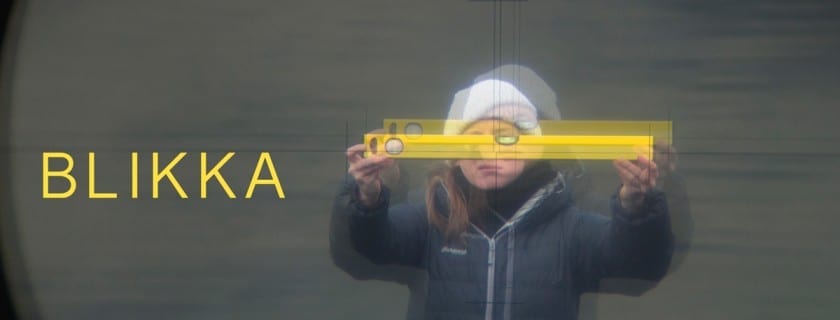Um Sequences
“Um leið og Sequences-hátíðin notar hugtakið „rauntími“ til að vísa til miðlunar í tíma, felur „teygjanlegur tími“ í sér hvernig nota má hugtakið um þá reynslu og upplifun að skapa list, með því að skoða hvernig listamenn eiga við tímann sem hráefni. Hugtakið „rauntími“ kallar svo ósjálfrátt fram orðið „órauntími“ og varpar þannig fram spurningum um hvers vegna afstrakt mælitæki eins og klukka teljist raunverulegri en tíminn eins og einstaklingurinn upplifir hann. Klukkan veitir vissulega samstillingu, en engu að síður er hugmynd okkar um tímann takmörkuð þegar tekið er tillit til smásærra eða jarðfræðilegra tímakvarða. Með því að teygja, bergmála og snúa upp á tímann fara verkin á Sequences VIII oft handan staðlaðra mælinga til að kanna óhefðbundin kerfi. Þessi verk minna okku á að hrynjandi hversdagsins ákvarðast ekki eingöngu af hefðum og stað, heldur getur hún líka verið einstaklingsbundin, sérsniðin jafnvel, eða rótgróin í náttúruöflum sem við höfum enga stjórn á.” Nánar
Æviágip listamanna
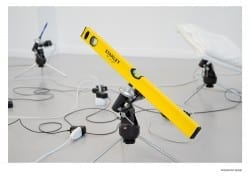 Jessica MacMillan (b. 1987) lives and works in Oslo. She holds a Master of Fine Art from the Academy of Fine Art in Oslo, and a Bachelor of Fine Art in sculpture and art history from the Massachusetts College of Art and Design in Boston. Through the medium of sculpture and installation, Jessica’s artistic production investigates concepts in astronomy and their relationship to the actuality of daily life on our planet: not only the tangible, physical directions and orientations—but also the distances and structures we can never fully experience with our limited senses. Here Jessica presents four kinetic sculptures from her installation Antiplanet (2017), which have been constructed using found objects and the same equipment and techniques that are used for guiding telescopes. The four sculptures in this installation are aligned with the axis of the planet, and rotate at the same speed–but in the opposite direction. Counteracting the rotation of the planet, these sculptures become physically aligned with fixed points in the sky.
Jessica MacMillan (b. 1987) lives and works in Oslo. She holds a Master of Fine Art from the Academy of Fine Art in Oslo, and a Bachelor of Fine Art in sculpture and art history from the Massachusetts College of Art and Design in Boston. Through the medium of sculpture and installation, Jessica’s artistic production investigates concepts in astronomy and their relationship to the actuality of daily life on our planet: not only the tangible, physical directions and orientations—but also the distances and structures we can never fully experience with our limited senses. Here Jessica presents four kinetic sculptures from her installation Antiplanet (2017), which have been constructed using found objects and the same equipment and techniques that are used for guiding telescopes. The four sculptures in this installation are aligned with the axis of the planet, and rotate at the same speed–but in the opposite direction. Counteracting the rotation of the planet, these sculptures become physically aligned with fixed points in the sky.
“There is a gap in the relationship between our everyday experience and our larger context: on a planet, in a solar system, within a galaxy. It can be argued that in astronomy, reality and appearance are more disconnected than in any other area of human experience.This creates a necessity for metaphor, and also the opportunity to explore the structure, materialities, and significance of our human experience from different angles. Scientific instruments often require calibration to keep them precise. To “calibrate” in this sense, is to take external factors into account while making adjustments for accuracy. This is what I hope to accomplish with my art—to offer a different kind of calibration: an opportunity for assessment of the scale of human life, the limits of experience, and our collective concept of (and hope for survival in) the future.” (Jessica MacMillan)
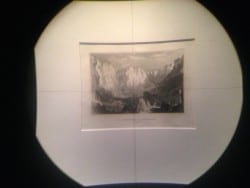 Maiken Stene (b. 1983) graduated from Malmø Art Academy and lives and works in Oslo and Sokndal, Norway. Maiken uses painting, installation, text, video, and sound to research the connection between geology and landscape painting. Her work studies how both disciplines have gradually formed nature and our understanding of it. In the video This Land is My Land (2014, HD video, 7 min.), Maiken uses, and irreversibly transforms one of her previous works, a scenographic painting based on a print from 1840 which depicts a Cornish tin-mine.
Maiken Stene (b. 1983) graduated from Malmø Art Academy and lives and works in Oslo and Sokndal, Norway. Maiken uses painting, installation, text, video, and sound to research the connection between geology and landscape painting. Her work studies how both disciplines have gradually formed nature and our understanding of it. In the video This Land is My Land (2014, HD video, 7 min.), Maiken uses, and irreversibly transforms one of her previous works, a scenographic painting based on a print from 1840 which depicts a Cornish tin-mine.
“I packed up the painting/set and drove it to a gravel pit in northern Skåne where, with good help from photographers and pyro-technicians, I blew up the landscape with dynamite. The sound is from a real blast recorded in the iron mine Titania in southwest Norway.” (Maiken Stene)
Presented as a video installation, the work includes the original print of the tin-mine, hung upside-down. It can be viewed through an old theodolite, a land survey tool used by mining companies, which flips the image by 180 degrees.
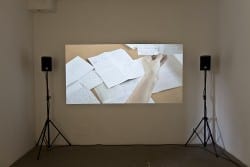 Malin Franzén (b.1982) studied at Malmö Art Academy. Working with video, objects, and installations, she often uses documentary material to explore her interest in myth, expansion, and the desire to achieve utopian change and convert others to one’s own vision. In a series of installations, she explores the role of legends in the emergence, expansion, and maintenance of religious and political movements. The most recent work in this series, Länge bor vi på ruinerna av det förgångna [For long we live on the ruins of the past] (2017), focuses on Swedish writer, feminist, and public intellectual Elin Wägner. In 1937, Wägner went on an archaeological field trip to Crete in search of historical examples of peaceful coexistence suggesting alternatives to the violent and war-torn times in which she lived. Following Wägner’s footsteps, Länge… asks what happens when one attempts to merge historical fragments into a new narrative about the past in order to point to an alternative way forward.
Malin Franzén (b.1982) studied at Malmö Art Academy. Working with video, objects, and installations, she often uses documentary material to explore her interest in myth, expansion, and the desire to achieve utopian change and convert others to one’s own vision. In a series of installations, she explores the role of legends in the emergence, expansion, and maintenance of religious and political movements. The most recent work in this series, Länge bor vi på ruinerna av det förgångna [For long we live on the ruins of the past] (2017), focuses on Swedish writer, feminist, and public intellectual Elin Wägner. In 1937, Wägner went on an archaeological field trip to Crete in search of historical examples of peaceful coexistence suggesting alternatives to the violent and war-torn times in which she lived. Following Wägner’s footsteps, Länge… asks what happens when one attempts to merge historical fragments into a new narrative about the past in order to point to an alternative way forward.
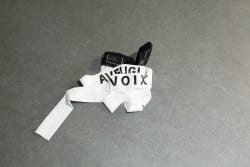
Yen Noh (b.1983) has received a BFA from Hongik University in Seoul and a MA in Transdisziplinäre Kunst from the University of Applied Arts Vienna. Looking into the gap between the “original” and “translation” in cultural relativity, Noh takes language and translation as her themes to produce “speech performance”, in which a spoken language becomes a critical agent to rethink the relationship between spoken language, speaking body and its mind. She is concerned with an archival mind in action and togetherness, in order to create a temporary, yet intimate community of thinking, dialogue and discourse.
When A Form Withdraws Itself is a “speech performance” series that deals with the gesture of withdrawal as affirmative. The series developed from a long-term artistic research into the performance and text works of the artist Theresa Hak Kyung Cha who explored spoken language, voice, and body as a critical intervention of identity. In this exhibition here, the objects of the performance’s documentation are shown, questioning what it means to document performance and what makes it so attractive to think of the relationship between documentation and performance. While a speaking body dominated the space during the performance, Yen is here interested in the ontological question of the visible and invisible transformation of objects in the post-performance. How does the spoken word resist being materialized, yet its technical information and transformation appear by and after performance? Yen experiments with these questions as a preparation for her artist book, “When A Form Withdraws Itself”.
![]()
